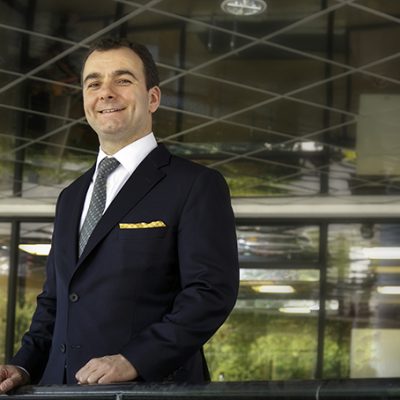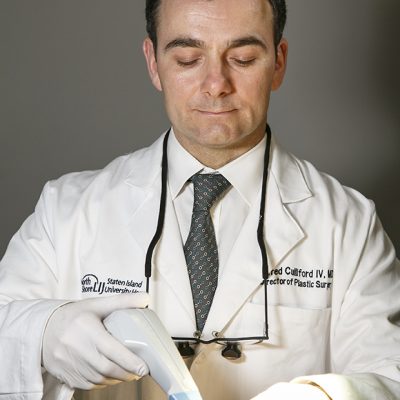
The Director pf SIUH’S Division of Plastic, Reconstructive & Hand Surgery, on the stunning leaps in his field’s scope, capabilities, and artistry
By Jessica Jones-Gorman • Photos By Amessé Photography
In the past 20 years, the field of plastic surgery has become geometrically more sophisticated, subspecialized, and technologically advanced. No longer entirely defined by cosmetic or reconstructive procedures, the specialty has grown and expanded thanks to modern advances in restorative procedures. And at Staten Island University Hospital, The Division of Plastic, Reconstructive & Hand Surgery offers a wide range of such services, for both children and adults.
“Plastic surgery is an incredibly broad discipline in which patients are essentially reborn,” noted Dr. Alfred Culliford IV, director of Plastic, Reconstructive and Hand Surgery. “We help the victim of an accident or trauma one day, a recovering cancer patient the next, and a child born with a congenital anomaly the following day. What other specialty can say that? We have the most varied patient population in all of medicine, and that’s what challenges me. I have operated on a child born 12 weeks premature and someone who was 101-years-old. Every problem is unique, and every procedure and consultation we perform has the ability to drastically change someone’s life.”
Dr. Culliford has performed over 2,500 operations at SIUH since joining its faculty in July 2006. Its reconstructive team (which includes his partner Dr. Lawrence Draper and physician assistant Agnieszka Lantowski) performs roughly 12 to 20 operative procedures each week, and consults with more than 100 patients.
Always emphasizing the importance of teamwork across the disciplines he works in, Culliford performs regular rounds in the hospital and teaches surgical residents both basic and advanced surgical techniques. (He is the site director for the Plastic Surgery Residency for the North Shore/Long Island Jewish Residency program.)
“Surgical education is a key to the future, and I try and pass on the knowledge base that I have to training residents, as I have had the good fortune to learn under numerous surgical giants during my ten years of training at leading medical centers.”With so many advances in his specialty, that education is increasingly monumental in scope.
“The field as a whole has truly evolved, and there is now certainly a more aggressive approach to solving patient problems with less invasive procedures—doing more with less, so to speak,” explained Culliford. “As our dynamic understanding of anatomy improves, we continue to unlock processes today that wouldn’t have been possible just a few short years ago.”
Dr. Culliford should know. After completing his undergrad at Wesleyan University and earning a medical degree with honors from New York University’s School of Medicine, he completed a five-year general surgery residency at NYU and graduated with distinction in research. He did a two-year research fellowship at Memorial Sloan Kettering Cancer Center and a three-year fellowship at the internationally renowned Institute of Plastic and Reconstructive Surgery at New York University Medical Center.
Certified by both the American Board of Surgery and the American Board of Plastic Surgery, he became the director of Plastic, Reconstructive & Hand Surgery at SIUH in 2013. He has been a full time faculty member and exclusively working at Staten Island University since 2006, and is currently studying to obtain his MBA degree, scheduled to graduate in December 2014.
“I chose surgery because I like working with my hands and there is this sense of immediate satisfaction when you are able to solve and fix a patient’s problem,” Culliford said. “I chose plastic surgery because of the nearly infinite variety of patient problems I would be treating, which I knew would keep me stimulated and challenged throughout my entire career.”
The doctor’s interests have centered on acute and chronic complex wounds, hand surgery, breast surgery, oncologic reconstruction, body contour surgery, and cosmetic surgery. He has authored articles in journals such as Plastic and Reconstructive Surgery, Annals of Plastic Surgery, and the Journal of Plastic, Reconstructive & Aesthetic Surgery. He is a contributing author to the plastic surgery texts Current Therapy in Plastic Surgery and Grabb & Smith’s Plastic Surgery, and has also presented at numerous national and local meetings. Here on Staten Island, his focus is broad.
“What I’ve observed in this community in particular over the past eight years is that more and more patients want to lead a healthier lifestyle,” he said. “People are coming in with significant amounts of weight loss—whether through surgery or because of diet and exercise—and they want to complete their fitness journey with body contour surgery. Staten Islanders have definitely become more body image conscious; they look better and naturally want to feel better about themselves. I have seen more consultations recently for breast reductions, breast augmentations, and abdominoplasty [tummy tuck] procedures, thanks in part to what I perceive as an improving fitness level in the borough.”
But it’s the reconstructive aspect of his field that Culliford said can impact patients even more immediately.
“Patients who want cosmetic surgery have generally been thinking about it for a long time. On the other hand, those who need reconstructive surgery are often dealing with a situation on a more time sensitive basis. Surgery to reconstruct a breast after cancer treatment or surgery to reconstruct a leg after a motor vehicle accident are two examples of the opportunities plastic surgeons have to improve patient’s lives.
“A young boy who has had over 20 surgical procedures to treat a congenital condition and now wants to become a plastic surgeon and a young woman who was a star basketball recruit from a local high school who required surgery on her foot right before the start of her senior season these are just a few examples of the kinds of cases I see. Without going into specifics, we did the surgery, she broke all school and local records, and was recruited to the school of her choice. It’s those types of procedures…the operations that help people live their everyday lives and allow them to do things they want to do that can really make the most impact.”
SIUH’s Division of Plastic and Reconstructive Surgery recently moved into a new office on 1000 South Avenue, which Culliford hails as a positive step for both patients and staff.
“It’s a wonderful, relaxed environment where our patients feel comfortable and very much at home,” he noted. “You see plenty of trees, and occasionally a deer in the surrounding woods that are visible from every patient examination room.”
An increasing number of treatments are being added to the staff’s repertoire of services. There is a thriving injectable practice, including Botox and Xiamen (which both smooth wrinkles and frown lines by paralyzing or weakening muscles) and a variety of fillers, among them Juvederm, Radiesse, Boletero, Restylane, and Sculptra (all of which can soften lines of facial expression by “filling in” the dermis).
“We’re now also using Exilis Therapy, an FDA-approved device that uses safe radio frequency waves to heat your skin and target fat cells,” Dr. Culliford stated. “The dual benefit is to tighten skin and reduce fat. The heat generated targets the collagen in your skin—producing a skin tightening effect—and targets the adipocytes [fat cells]. Exilis is part of some of the new and innovative advances that are really improving and modernizing the field that we offer our patients.” •
Alfred T Culliford IV, MD FACS
Director, Division of Plastic, Reconstructive & Hand Surgery
1000 South Ave., Suite 100 / 718.226.6780
Carissa Gagliardi
Office Manager for Plastic, Reconstructive & Hand Surgery
718.226.1694
North Site: 475 Seaview Ave. / 718.226.9000
South Site: 375 Seguine Ave. / 718.226.2000





